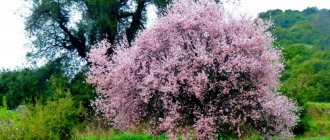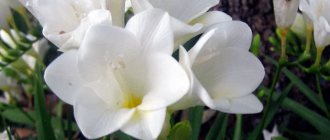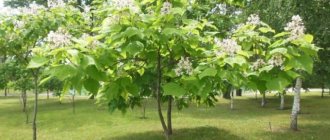Forsythia is a bush-shaped plant. In nature, there are dwarf varieties, up to one meter in height, and species up to 3 meters, forming a full-fledged tree crown. The bark of the trunks is rough in texture, gray with a brownish tint. The leaves are simple, oval-shaped, serrated along the edges, from 2 to 14.5 cm long. The flowers are bell-shaped, bright yellow in color, form small fruit-boxes with the seeds of the plant. Pruning and caring for forsythia is not difficult, so no special skills are required.
Features of growing forsythia at home
In European countries, it is surprising if forsythia is not planted along an alley or in a park. This is a common plant for Central Europe. The tree is a symbol of the arrival of spring, because it is one of the first to bloom. It is happily grown in their yards and gardens and is actively used by city residents for decoration in landscape design.
The ornamental plant is undemanding to care and unpretentious in relation to the soil. Therefore, if you tried to care for forsythia in the fall, in the spring the tree will thank you with profuse flowering.
Forsythia begins to dapple with yellow flames when the gray streets have not yet woken up from the winter cold. Early flowering of bushes is a property that distinguishes a plant from other green spaces.
So what features does the plant have, how to care for it, and what is needed to prune forsythia in the fall in order to grow a lush and healthy bush that is popular with gardeners? Read on.
Types and varieties
There are 7 types of forsythia in total. Each has its own distinctive characteristics and is divided into varieties.
European forsythia (Forsythia europaea) is the most common variety in our area. The height of the bush does not exceed 2 m. It has oblong leaves up to about 7 cm long. Blooms with golden yellow bell-shaped flowers. It is durable and can live up to 70 years.
Forsythia ovata is a species that blooms earlier than all others. This is a spreading shrub up to 2 m high, has oval leaves, pointed upward, and bright yellow flowers. In autumn it pleases the eye with colorful leaves. Frost-resistant. Known varieties:
Hanging forsythia (Forsythia suspensa) - common in East Asia. It has long branches going down to the ground. The flowers are quite large and orange-yellow in color. Several varieties are known:
- Motley;
- Forsythia Fortune;
- Purple-stemmed;
- Forcisia is deceptive.
Forsythia Giraldiana - similar in appearance to European forsythia, but differs in a lighter shade of flowers. The leaves are dark green, large, up to 10 cm long. It also reaches a height of up to 2 m and has straight stems.
Dark green forsythia (Forsythia viridissima ) is a shrub with a height of up to 3 m. It received its name due to its dark large (up to 15 cm in length) leaves directed upward. It has light yellow flowers collected in bunches. Drought resistant.
Snow or white forsythia (Forsythia abeliophyllum) . The plant got its name due to the white color of the flowers. The height of the bush is about 2 meters, the leaves are small, up to 8 cm, in summer their lower side becomes slightly purple.
Intermedia forsythia (Forsythiax intermedia) is a hybrid of drooping and dark green forsythia. It begins to bloom only from 4 years of age. The leaves are dark green in color, the flowers are bright yellow. Resistant to frost and drought. Grows up to 3 meters. Known varieties:
See photos of forsythia species in the gallery:
When to plant an ornamental plant
Planting and replanting of bushes is carried out in spring or early autumn, before the first frost, so that forsythia has time to take root before the cold weather. The best place for growing is a sunny or semi-shaded area protected from the wind. Although forsythia is shade-tolerant, what wildly flowering plant does not like light!
You can plant bushes on any type of soil, but forsythia takes root best in slightly alkaline dry soil. If the soil on the site is highly acidic, then dig it up with wood ash before planting the seedlings.
Preparing holes for planting
Before placing the seedlings in the ground, drainage (broken brick, crushed stone) 15 cm thick is poured onto the bottom of the hole, and on top - a mixture of leaf soil, sand and peat in a ratio of 2:1:1, supplemented with wood ash (no more than 200 g). The seedlings are placed in the hole and dug in. The near-trunk part must be compacted and watered abundantly with water.
Important! Pruning forsythia in the fall concerns not only adult trees, but also planting material, so the seedlings are pre-cleaned.
Plants planted in spring will require regular care in the future.
Pruning forsythia in the fall, planting and caring for plants differ from those done after winter. In this case, it will be necessary to mulch the area, regardless of the type of plant planted. The covering material should be selected taking into account breathability, so that in winter, during periods of thaw, flower buds do not rot under the “hood”.
Reproduction
The plant propagates quite simply - by layering, cuttings and, less often, by seeds.
By layering
This method is most often used because of its simplicity.
If the branches of forsythia bend towards the ground and they come into contact with it for a long time, they will soon take root on their own.
But it’s better to monitor the reproduction yourself and choose the best branch, bending it to the ground and digging it in.
It is necessary to cut the bark in the place where the branch is buried. In the spring, when the shoot takes root, it can be transplanted from the main bush to another place.
In a year, the young forsythia will already bloom.
Cuttings
This method is also quite simple. Lignified and young shoots can reproduce . Young green cuttings are cut in early summer.
To begin with, they are kept in a root solution for some time, planted in specially prepared soil and covered with film to create greenhouse conditions .
Already in the fall the cuttings will take root and take root well.
At this time, it can be placed in a permanent place and covered with a ball of dry foliage for the winter.
Lignified cuttings for planting are cut in the fall. Their length should be up to 18 cm. They are planted in the ground 10 cm deep. Several buds are left on the surface. In order for the plant to overwinter, it is covered with dry leaves.
Rules for caring for forsia
Caring for a plant is practically no different from the classic care scheme for any other bush or tree. If there is enough precipitation in the summer, there is no need to organize watering. Forsythia receives enough water and moisture from the atmosphere. During dry seasons, the bushes are watered 1-2 times a month at the rate of 10-15 liters of water for each plant.
After watering the trees, loosen the soil underneath them to the depth of a garden trowel, and remove weeds. Such simple actions ensure free access of air to the roots of plants. After loosening, the area around the bush trunk is mulched using compost or dry soil.
Fertilizers for forsythia are applied three times per season:
- With the onset of spring, rotted manure is spread in a thick layer around the tree trunk, departing about 3-5 cm from the trunk itself. Afterwards, water generously. Manure simultaneously performs two tasks: it nourishes the bush with organic substances and acts as mulch.
- During April flowering, a complex of mineral fertilizers is applied: 60-70 grams per 1 m2.
- At the end of the flowering period, when the plant lays flower buds for the next year, Kemira-universal is used for feeding: 110 grams per 1 m2.
Forsythia after flowering and wilting
To protect forsythia from winter frosts, the tree trunk circle is covered with a ten-centimeter layer of dry foliage, the branches are bent to the ground and pinned, and covered with spruce branches on top. In early spring, the cover is removed, the branches are detached, and dry leaves are removed from the trunk. Young plants are completely covered with spruce branches for the winter. In snowy winters, forsythia overwinters well even without shelter, but who knows in advance what kind of winter it will be?
Planting white dogwood - everything you need to know about care
Forsythia pruning
Pruning forsythia in the fall may seem difficult for beginners, but these are just general rules for caring for the plant.
Young bushes can only be sanitized. At the same time, frozen, shriveled, broken shoots are removed. In mature bushes and trees, with the onset of the spring thaw, the ends of branches damaged by frost are cut off. The main pruning should be done in the summer, after the forsythia has faded: the branches are cut in half, old and dead branches and shoots are cut off, leaving 4-6 cm from the soil level (base of the trunk).
Pruning forsythia to prepare for winter involves cleaning and shaping the crown of the bush (cup-shaped or spherical). If it is necessary to rejuvenate an adult plant, cut off all branches, leaving 2/3 of the base, to stimulate the growth of young shoots. It is not recommended to overuse such “haircuts”, otherwise the bush will give abundant growth, but small flowering. It is recommended to carry out rejuvenating pruning without compromising the decorative properties of forsythia 3-4 times a year.
How to approach the procedure correctly
Pruning European forsythia is an important stage in plant care, affecting the further development and flowering of bushes. If you have never encountered such a procedure before, and you have little experience in removing wilting shoots, leave the cleaning for the summer. The end of flowering means that you can start cutting off the branches.
Pruning forsythia in autumn can have a negative impact on spring flowering - the buds simply will not bloom. Therefore, it is better if you have no experience working with garden plants, leave this matter for the summer or seek help from a gardener.
Off-season pruning involves clearing the bush of branches that are excessively thickening the central part of the plant. In the future, this procedure is carried out in order to update the decorative shape of the bush if the shoots are knocked out of the crown ball.
Pruning forsythia in the fall is a way to get rid of excess and damaged branches. When carrying out the procedure, make sure that it is not too intense, so don’t get too carried away. By cutting off too many shoots, even if they are superfluous, you will weaken the plant and its immune system before frost.
Another important nuance that you need to know when planning to prune forsythia before winter: carry out the procedure in early autumn so that the cuts have time to heal before the onset of cold weather.
Bush pruning technology
In some cases, pruning of bushes is carried out in the spring, even before flowering. Carefully inspect the bush to identify broken, frozen or damaged shoots and remove them. Pay special attention to the tips of the branches of an ornamental plant - they most often suffer from cold weather. By carrying out the procedure correctly and removing a moderate amount of weak branches, you will make sure that pruning will not negatively affect flowering, but will only contribute to its activity.
Gardeners recommend shortening the shoots by half immediately after flowering. The peculiarity of the procedure is that pruning is carried out either on a side branch or above the strongest bud on the branch.
When cleaning old shoots of forsythia bushes, it is better not to cut them off completely, but to cut them off, leaving a small protrusion. This pruning will stimulate the new growth of strong young shoots, which will subsequently form a lush crown of the plant.
Forsythia trimming scheme
The pruning scheme is not complicated. Typically, young, highly branched shoots are shortened by about 1/3. The old ones are removed almost completely, but only in the spring, since new buds are laid on them in the fall. By postponing the procedure until September, you may not be able to wait for wild flowering next year.
Those branches that spread along the ground or come into contact with it must be removed. Such shoots can give new roots and grow into the ground. Once every four years, the bush is completely rejuvenated in order to prolong its life and renew the crown. When pruning, all old shoots are cut off at the root, leaving up to 5 young healthy shoots.
Forsythia is an ornamental plant of unsurpassed beauty that gives joy and delight from contemplating the bright appearance of the bushes that decorate and enliven the area adjacent to the house, a summer cottage, or an alley.
Botanical description
Forsythia, as already mentioned, is a small tree or bush with a height of one to three meters. The bark has a rough texture and a gray-brown tint. The leaves of some species are trifoliate, but in most forsythia they are simple, without stipules, opposite, oval in shape with jagged edges, from two to fifteen centimeters long. Bell-shaped flowers are bright yellow. Forsythia blooms in early spring and lasts up to three weeks, sometimes even longer. The fruit is a capsule with winged seeds.
- Acidanthera: cultivation and care, types and varieties











